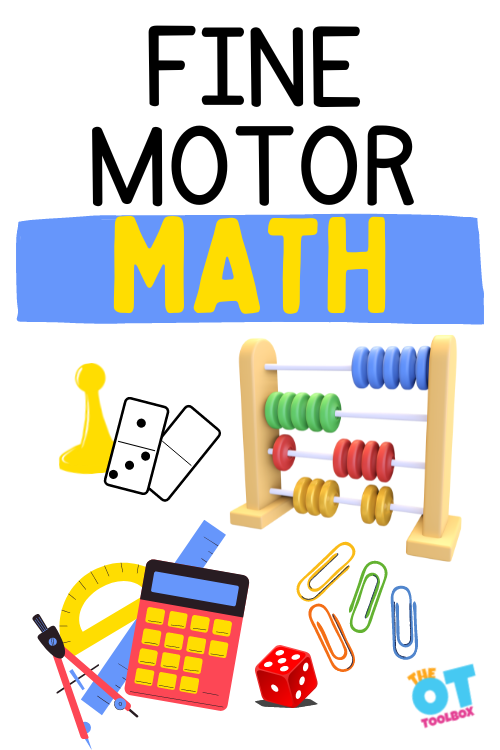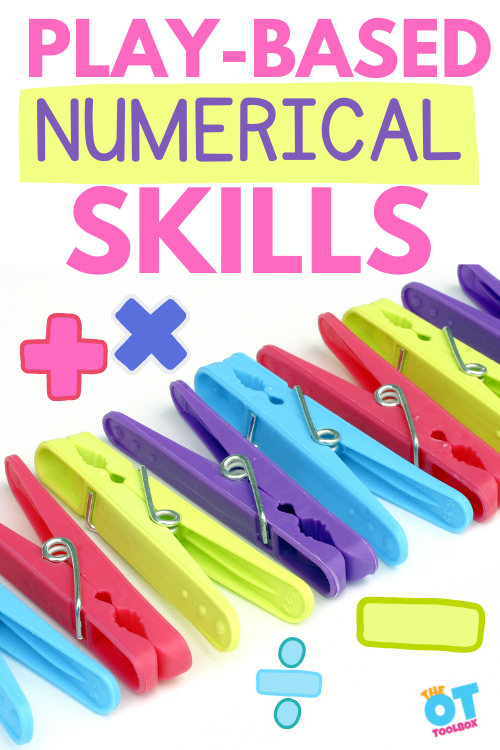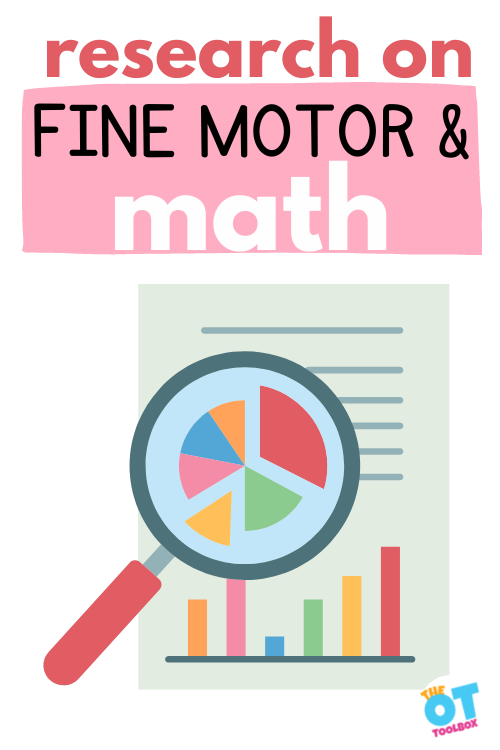Fine motor math is more than just a fine motor activity with math concepts. Here, we are covering specifically, the topic of how fine motor skills and math skills are connected. Increasing research is showing the connection between math and fine motor. Here, we’re looking at how these two seemingly different areas are closely connected. We covered some of this connection in our resource on fine motor STEM.

Fine Motor Math
In young learners, we see fine motor and math more often than with older students. The ability to problem solve (an early math building block) and fine motor go hand in hand. But it doesn’t stop there. We see in early learning the use of counters to support one-to-one correspondence.
Other early math skills that utilize fine motor skills:
- Shapes
- Spatial concepts
- Math patterns
- Same and difference
- Number identification
- Counting objects
These early mathematical concepts support numerical skills and more abstract thinking further along. The development of early mathematical skills builds upon itself.
Later we see primary school children using fine motor math activities in hands-on math activities. Manipulatives like paper clips are used to measure. Counters are used to add and subtract. Snap blocks are used to grasp grouping and counting skills.

What is a numerical skill?
A numerical skill is an ability to understand and work with numbers. This includes a range of math abilities, from counting and recognizing numbers to performing mathematical operations such as addition, subtraction, multiplication, and division.
While it may not seem obvious, there are underlying skills that impact numerical skill abilities and math development.
Numerical skills are essential for a wide range of tasks, from simple daily activities such as telling time and measuring ingredients to complex tasks such as calculating probabilities and analyzing data.
Some common numerical skills include:
- Counting: The ability to count objects and recognize number symbols.
- Number recognition: The ability to identify and name numbers.
- Comparing numbers: The ability to determine which number is greater or smaller than another.
- Addition and subtraction: The ability to add and subtract numbers.
- Multiplication and division: The ability to multiply and divide numbers.
- Estimation: The ability to make approximate calculations and estimations.
- Measurement: The ability to measure quantities such as length, weight, and volume.
Numerical skills develop gradually over time and are influenced by factors such as genetics, environment, and early experiences.
Numerical skills can be improved through practice and instruction, and early intervention can help children develop a strong foundation in these skills that can benefit them throughout their lives.
Piaget, in his theory of play, theorized that people learn by doing. We call this kinesthetic awareness, or the connection between the body and the brain.
Early mathematical skill involves counting with the fingers, learning to isolate digits, and clapping/tapping out numbers. This is the beginning of fine motor skills and math development.
Fischer, Stoeger, and Suggate concluded that, “FMS (fine motor skills) are closely related to early numerical skill development through finger-based numerical counting that aids the acquisition of mathematical mental representations.” Fischer, Stoeger, Suggate. 2017.
A relatively new math program called Touch Math, uses kinesthetic awareness by having students touch the numbers while counting the dots, in order to make a better connection to counting, rather than rote memorization.
It has been hypothesized that early acceleration in mathematics frees brain space and working memory. This allows the brain and working memory to be utilized on more complex equations.
What does this mean?
It means that counting on fingers is ok!
It is a great stepping stone to moving further into math concepts using other methods such as number lines, touch math, memorization, or counting objects. This is a critical stage in development of fine motor and math skills.
Let’s explore some of the ways fine motor skills and math development are correlated:
- Ancient mathematicians used an abacus method of sliding beads across a platform to calculate sums thus incorporating fine motor skills into math
- Modern math involves using a calculator, dependent on fine motor precision to press the correct keys in sequence
- Stringing beads develops fine motor skills while working on patterns, copying designs, counting, and sorting
- Unifix cubes (or snapping cubes) are used for counting, addition, and subtraction, but also involve fine motor precision to move, count, touch, stack, and sort the cubes.
- Other tools such as a ruler, protractor, stencil, tape measure, pencil, scissors, or compass rely on accurate fine motor skills
- Graph paper, number lines, timed tests, and lining numbers in rows all require fine motor precision
- Flash cards, clothespins, manipulatives, and worksheets are some more tools used in math development
DEVELOPING MATH SKILLS THROUGH FINE MOTOR PRECISION IS NOT NEW
Educators have been using these tools forever, this is not new.
What IS new, is the amount of children starting school with below average, or poor fine motor skills. This is in addition to limited reading, math, and writing skills.
Below average development in the early years may be due to a lack of exposure, too much time on screen electronics, or a physical impairment. The pandemic is largely to blame in recent years due to the amount of children being home, not exposed to materials, concepts, and tools.
If children are struggling to hold a writing tool, manipulate objects, or move their fingers, how are they going to focus on the higher math concepts such as long division, geometry or algebra?
Older students may be unable to do fractions, multiplication, or larger sums, due to poor baseline skills. These students are still trying to figure out how to count their fingers, put their numbers in columns, or do simple addition, rather than solving equations.
How can you help?
Go back to the basics. Take a break from fancy computer programs and iPad apps. Focus energy on working with math manipulatives:
- fingers
- clothespins
- beads
- scissors
- pennies
- paper clips (Specifically use this paperclip math activity or our base ten operations activity.)
- Unifix cubes
- Stickers
- stencils
- rulers
- compasses
- craft pom-poms
- magnetic numbers
- dot stickers
- pipe cleaners
- play dough
- play dough mats
- golf tees
- Sensory trays and number cards
- Playing cards
- Pegs and pegboards
All of these math manipulatives build the foundational skills needed for higher learning.
Building gross motor skills will also develop core strength, upper body strength, shoulder stability, and wrist/hand strength.
Think of all of the ways you could use paperclips, not only to develop math skills, but improve fine motor precision at the same time.
A box of odds and ends from the junk drawer or tool shed serve as great manipulatives for both understanding math concepts, and developing fine motor skills. We have several ideas for occupational therapy kits to use for fine motor skill development. A math kit could easily support learning and motor skills.
Curriculums all around the world are shifting their focus to more computer based learning as it is “more appealing” to learners. While this might be accurate, it is not well rounded or beneficial to developing crucial skills. If you are unable to eliminate all the computer based work, add fine motor manipulatives along with these lessons to improve skills. Worksheets are preferable to computer based programs as they incorporate pencil/crayon use, cutting, and gluing.
Check out this great Outer Space Fine Motor Pack that includes bead activities, counting, sorting, graphing, and tool use of scissors/tongs/pencils. Building fine motor skills is not only essential for math, but handwriting, self care, and life skills.

Research on Fine motor and math skills
Research is offering more and more evidence that there is a positive correlation between fine motor development and math abilities in children. Depending on the age of the child and the fine motor contribution, we can visibly see the impact of fine motor dexterity and hand eye coordination on math manipulatives.
While we know that fine motor development and the small motor movements of the hands and fingers, hand strength, dexterity, and coordination, several studies have found that children who have well-developed fine motor skills tend to perform better on math tasks than those who do not.
For example, a study published in the Journal of Experimental Child Psychology
found that preschool children who had better fine motor skills were also better at math skills. These early math skills specifically included:
- counting
- number identification
- pattern recognition
Specific fine motor tasks that seem to play a role in math skills (according to this study) were pegboard activities and threading beads activities.
As occupational therapy practitioners, we know the activity analysis behind these fine motor tasks.
To complete a pegboard activity, fine motor contributions include:
- Separation of the sides of the hand
- Arch development
- In-hand manipulation
- Eye-hand coordination
- Open thumb web space
- Tripod grasp
- Pincer grasp
- Finger isolation
- Thumb opposition
- Wrist extension
- Dexterity
Similarly, the fine motor contributions that are needed for threading beads includes:
- Arch development
- In-hand manipulation
- Eye-hand coordination
- Open thumb web space
- Tripod grasp/pincer grasp
- Finger isolation
- Thumb opposition
- Wrist extension
- Dexterity
- Bilateral coordination
So, when we look at the connection between fine motor skills and early math skills, we can connect the dots.
There’s more…
According to Pitchford, Papini, Outhwaite, and Guilliford, “The influence of fine motor precision and math abilities emerges over the first year of schooling, and might be closely linked with the numeracy skills children are acquiring, and the practice children have in writing numbers, as well as carrying out other math based activities that require fine motor precision”.
Taking this further, “Fine Motor Integration remains a significant predictor of math ability, even after the influence of non-verbal IQ has been accounted for.” Pitchford, Papini, Outhwaite, Guilliford, 2016. Through different studies, such as the one above, there has been a correlation between fine motor skills and math development.
It might be that both fine motor tasks and math activities require the manipulation of abstract concepts.
For example, to add, subtract, multiply, and divide, manipulate fractions, shapes, decimals, and percentages, children need to grasp the concept of numerical symbols and steps to complete math processes. The child needs to think abstractly. Math requires mental manipulation of concepts, numbers, and symbols.
In fine motor skill activities, the child needs to manipulate small objects using their hands. While the manipulatives or objects are physical items, the child needs to manipulate the object in order to accomplish a specific task. Before they can do the task, they need to see the process in their mind’s eye.
Both math and fine motor tasks require spatial relationships, and visual processing skills.
For some kids, this can be a real stumbling block.
The child might be able to manipulate numbers and symbols to complete math tasks but fine motor tasks is a challenge. It’s the spatial relations and the ability to conceptualize the fine motor task in their mind’s eye followed by follow-through.
However, some individuals can strengthen one domain by building on skills of the other.
A child who is strong in fine motor skills but weaker in math concepts can use manipulatives to build on math skills.
A child who lags behind in fine motor dexterity and manipulation skills can utilize math skills to build strength in fine motor.
Another study published in the Journal of Learning Disabilities found that fine motor skills were significantly correlated with math achievement in children with learning disabilities.
In that study, the researchers found that fine motor skills in children with learning disabilities were significantly correlated with math achievement. They determined that the children with better fine motor skills had higher math achievement scores, and especially math reasoning and problem solving skills.
The researchers used fine motor tasks like drawing lines, copying shapes, and using tweezers to pick up small objects. Children with stronger fine motor skills in those tasks were able to achieve higher skills in addition, subtraction, multiplication, and division problems.
Tips to improve fine motor math
Modern day learners are so reliant on calculators, simple math such as making change, calculating a tip percentage, or figuring out a discounted price, requires the use of technology.
I have had to tell shopkeepers, and people at garage sales how much change to give me while they were whipping out their phones to calculate $20.00-5.00.
While I understand we are in the technology era, it saddens me to see the foundational skills being lost or forgotten. Some classrooms have eliminated pencils/crayons/scissors entirely, in favor of using an iPad.
We can support kids who struggle with both math and fine motor skills (or one skill area of the other…)
Other tips to support a student who struggles with fine motor skills to improve their math skills (and vice versa):
- Incorporate math and fine motor in the classroom- Encourage parents and educators to incorporate fine motor skills into their lesson plans as this correlates to improved math and writing scores. When therapy providers utilize push-in model of therapy this can happen efficiently.
- Use manipulatives: Manipulatives are a fine motor tool, or physical objects that students can use to represent math concepts. For example, you can use blocks, counters, or beads to help students understand numbers, addition, and subtraction. Providing manipulatives can help students with fine motor difficulties to engage with math concepts in a more hands-on way, which can enhance their understanding and make learning more accessible. By using manipulatives in math, students grasp the abstract concepts using concrete objects and are offered an opportunity to practice motor skills. For those struggling with the fine motor concept, you can modify the manipulatives to make them larger or easier to manipulate.
- Use technology: While it’s important to reduce screen time (use this screen time checklist to support this need), the fact is that technology is here to stay. Many technology tools, such as calculators or digital math programs, can help students with fine motor difficulties to engage with math concepts without having to rely on handwriting or drawing skills. For example, a student can use a digital drawing tablet to practice writing numbers and math symbols, or use a speech-to-text program to dictate math problems. This is an adaptation for students that can help them thrive.
- Focus on the student’s strengths: Students with fine motor difficulties may have strengths in other areas, such as verbal reasoning or visual-spatial skills. By focusing on these strengths, you can help students to engage with math concepts in ways that are more comfortable and accessible for them. For example, you can use visual aids, such as diagrams or charts, to help students understand math concepts, or engage them in verbal discussions about math problems.
- Focus on a student’s interests: Occupational therapy providers love to use a client’s indivudualized interests in building skills because the motivation improves when a meaningful theme is used. Try using manipulatives that support interests, or math problems that focus on a specific topic or theme.
- Provide targeted fine motor practice: Fine motor skills can be improved through targeted practice. For example, students can practice using tweezers (like this tweezer math activity), threading beads, or drawing shapes to improve their fine motor control. By providing targeted fine motor practice, you can help students to develop the skills they need to engage with math concepts more effectively.
- Use multi-sensory approaches: Engaging multiple senses can help students with fine motor difficulties to better understand and remember math concepts. For example, you can use music, movement, or tactile experiences to help students engage with math concepts in a more holistic way.
All of these tips can be graded to meet the individual’s needs.
In the Fine Motor Kits here on The OT Toolbox, you’ll find various fine motor numerical activities designed to support math and motor skill development.
Working on fine motor skills, visual perception, visual motor skills, sensory tolerance, handwriting, or scissor skills? Our Fine Motor Kits cover all of these areas and more.
Check out the seasonal Fine Motor Kits that kids love:






Or, grab one of our themed Fine Motor Kits to target skills with fun themes:
- Frogs Fine Motor Kit
- Unicorns Fine Motor Kit
- Vehicles Fine Motor Kit
- Apple Fine Motor Kit
- Back to School Kit
- Sports Fine Motor Kit
- Outer Space Fine Motor Kit
- Fairytale Fine Motor Kit
- Plus more in our shop!
Want access to all of these kits…and more being added each month? Join The OT Toolbox Member’s Club!

Victoria Wood, OTR/L is a contributor to The OT Toolbox and has been providing Occupational Therapy treatment in pediatrics for more than 25 years. She has practiced in hospital settings (inpatient, outpatient, NICU, PICU), school systems, and outpatient clinics in several states. She has treated hundreds of children with various sensory processing dysfunction in the areas of behavior, gross/fine motor skills, social skills and self-care. Ms. Wood has also been a featured speaker at seminars, webinars, and school staff development training. She is the author of Seeing your Home and Community with Sensory Eyes.






